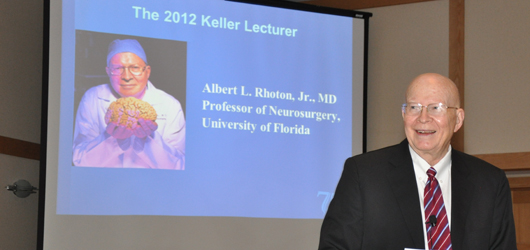
Albert L. Rhoton, Jr., MD, Professor of Neurosurgery at the University of Florida, wowed a gathering of surgeons and surgeons-in-training Wednesday with full-color 3D images of skull base anatomy during the inaugural Keller Lectureship at the Kingsgate Marriott, near the University of Cincinnati (UC) Academic Health Center campus. The captivating presentation was sponsored by the Mayfield Education and Research Foundation.
Dr. Rhoton, a mentor to Jeffrey Keller, PhD, for whom the lectureship is named, gave a 3D tour of skull base geography, noting complex approaches to tumors, aneurysms and other pathologies deep inside the brain. UC faculty members and medical residents watched the eye-popping imagery, produced with TrueVision® technology, while wearing 3D glasses.
Dr. Keller, Research Professor of Neurosurgery & Anatomy and Cell Biology at UC and the Mayfield Clinic, described Dr. Rhoton during his introduction as “the Vesalius of the 21st century” and noted his authorship of 400 peer-reviewed publications. “Throughout my career, every time I looked in the literature, there was Dr. Rhoton, and he’d done it before,” Dr. Keller said.
In creating 3D anatomy of the nooks, crannies and passageways through the skull – through nasal passages and orbital structures to the base of the brain – Dr. Rhoton has sought to see the anatomy “through x-ray vision” and to make “a delicate, awesome and fateful experience more gentle and safe for patients.” Accomplishing this, he said, means making careful dissections of muscle and precise key-hole (or burr hole) incisions, knowing what bones to cut and how to cut them, preserving blood vessels and nerves, and getting good cosmetic results.
The best image guidance system, he said, “is knowledge of microsurgical anatomy.” His brilliant images facilitate that knowledge by leaping out from the screen, cranial bones jutting toward you and fissures vanishing in the distance. The images, which are assisting students young and old in their navigation of the skull base, are available in 2D and 3D on iTunes U and are being assembled for Blu-ray by the American Association of Neurological Surgeons.
Dr. Rhoton’s specific goal on Wednesday was to guide his audience in transcranial and transnasal approaches to the sphenoid, a dramatic bone at the base of the cranium that, with its wing-like expansions, resembles a giant moth. “The sphenoid gives access to many areas,” Dr. Rhoton said. “We approach largely from above, but also from below.”
“Dr. Rhoton brings back to us the keys to anatomy, because anatomy is the highway by which we perform neurosurgery,” said Stewart Dunsker, MD, Professor Emeritus of Neurosurgery and a retired Mayfield neurosurgeon. “He’s able to make it so that we can all see it. He’s taken the field of anatomy that people thought was static and made it dynamic and made the practice of cadaver anatomy come alive.”
Philip Theodosopoulos, MD, a Mayfield Clinic neurosurgeon and skull base specialist, said he has seen Dr. Rhoton present at least 15 times and each time has learned something new. “This is a level of teaching we’ve never seen before,” Dr. Theodosopoulos said. “Even those who are not experts can learn something from this type of presentation.”
“Whenever you listen to someone who is an incredible expert like Albert Rhoton, it inspires you,” said Andrew Ringer, MD, a Mayfield Clinic neurosurgeon and endovascular specialist. “No matter how experienced you are, he can always show you a different perspective.”
Indeed, no one was sleeping through this lecture, not even neurosurgical resident Joseph Serrone, MD, who had been up all night and immersed in a trauma case in the operating room between 2:30 and 5 a.m. In a favorite professor’s ploy, Dr. Rhoton singled out Dr. Serrone for a short and very public anatomy quiz.
Dr. Serrone walked stoically to the front of the room, and Dr. Rhoton asked, “How many bones are in the walls of the orbit?”
“Seven,” Dr. Serrone replied.
“Well, that’s right,” Dr. Rhoton said. “Name them for me.”
— Cindy Starr